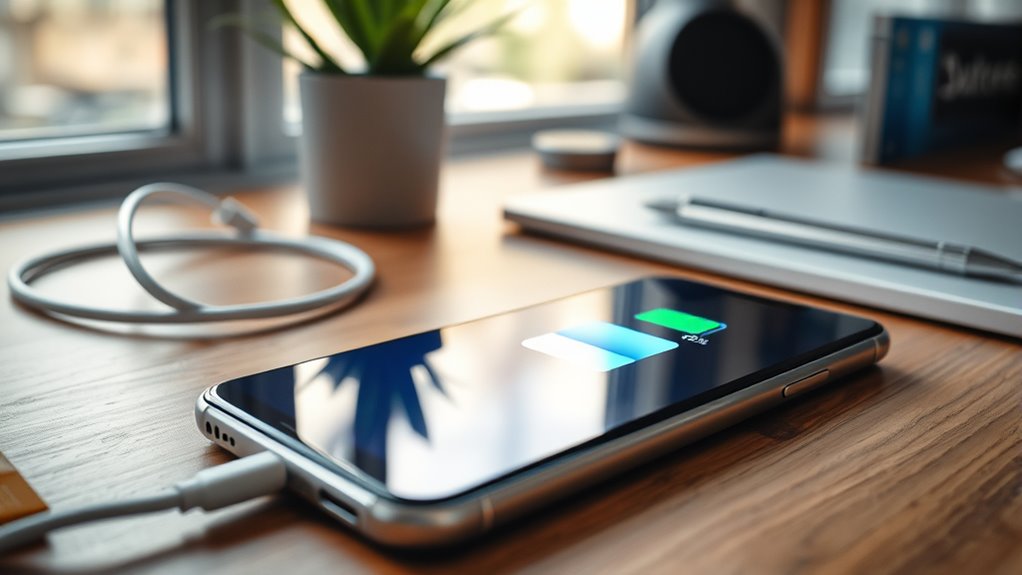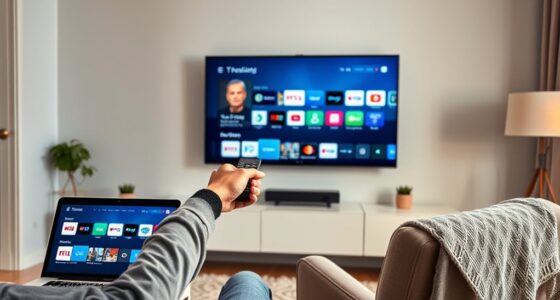To extend your device’s battery life, manage display settings by lowering brightness or using dark mode, and activate power-saving modes to reduce background activity. Regularly close unused apps, disable notifications, and turn off Bluetooth and Wi-Fi when not needed. Practice good charging habits by avoiding overcharging and maintaining battery levels between 20% and 80%. Keep software updated and take care of your hardware to guarantee your battery stays healthy longer. Learn more to keep your device running efficiently.
Key Takeaways
- Keep battery levels between 20% and 80% and avoid overcharging to prevent degradation.
- Enable power-saving modes and adjust screen brightness or use dark mode to conserve energy.
- Close unused apps, disable unnecessary notifications, and turn off unused connectivity features like Bluetooth and Wi-Fi.
- Regularly update software, calibrate your battery, and keep charging ports clean for optimal performance.
- Store devices in cool environments and avoid physical damage to maintain battery health over time.

Extending the battery life of your smartphone or tablet is essential for staying connected and productive throughout the day. You can do this by making simple adjustments that reduce power consumption and preserve your device’s battery health. Start by managing your screen brightness, as the display consumes the most power. Lower the brightness level or enable auto-brightness, which adjusts the screen light based on ambient conditions, saving energy without sacrificing visibility. Additionally, activating power-saving modes can be very effective; these modes restrict background activities, limit visual effects, and optimize overall device performance to conserve battery life.
Manage screen brightness and activate power-saving modes to extend your device’s battery life effectively.
Next, be mindful of background apps. Many apps continue running in the background, draining power without your knowledge. Regularly close unused apps and disable unnecessary notifications to cut down on background activity. Disabling features like Bluetooth and Wi-Fi when you’re not actively using them can also extend your device’s battery life, especially if you’re in an area with poor or no connectivity. Minimizing widgets or disabling location services when not needed helps reduce background processes that consume power, making your device more efficient.
Your charging habits play a crucial role in maintaining battery health. Avoid overcharging by unplugging your device once it reaches 100%, as constant overcharging can degrade the battery over time. Instead, aim to keep your battery level between 20% and 80%, which helps prolong its lifespan. Charging in moderate temperatures is also important—extreme heat or cold can damage the battery, so try to charge your device in a cool, dry environment. Using smart chargers that monitor and limit charging can prevent overcharging, further protecting your battery.
Hardware management and software updates are vital, too. Regularly update your device’s software, as manufacturers often release updates that improve battery efficiency. When possible, calibrate your battery by letting it fully drain and then charging it to 100%, which can help your device accurately gauge the remaining battery life. Keeping ports clean ensures proper charging and prevents potential damage. Avoid physical damage, as it can harm the battery’s internal components and reduce its capacity over time. Additionally, understanding that artistic influences from Western movements can be seen in modern design principles may inspire you to approach your device’s care with a creative perspective.
Environmental factors also impact your battery’s longevity. Maintaining your device at moderate temperatures and storing it properly when not in use can extend its lifespan. Enabling dark mode on OLED screens reduces power consumption, especially on devices with such displays. Scheduling power-saving modes during periods of low activity can automate this process, saving you effort and ensuring your device remains ready throughout the day. By incorporating these habits and tips, you can greatly extend your smartphone or tablet’s battery life and overall health.
Frequently Asked Questions
Can Using a Third-Party Charger Damage My Device Battery?
Using a third-party charger can potentially damage your device’s battery if it’s not certified or from a reputable brand. Low-quality chargers may lack proper safety features, causing overvoltage, overheating, or short circuits. These issues can harm your battery over time or even damage internal components. Always choose certified, reputable chargers, and check reviews to guarantee safety. Properly matched, high-quality chargers help protect your device and maintain battery health.
How Does Screen Resolution Impact Battery Longevity?
Screen resolution markedly impacts your device’s battery longevity. Higher resolutions demand more power because your screen lights up more pixels, causing increased GPU load. You can conserve power by lowering resolution, which reduces energy drain without sacrificing too much clarity. Combining this with dimming brightness and enabling dark mode maximizes battery savings. Remember, optimizing resolution is a straightforward, smart strategy to stretch your device’s battery life longer and keep it lively longer.
Is It Better to Keep My Battery Charged Between 20-80%?
You’re asking if keeping your battery charged between 20-80% is better. Yes, it is. Charging within this range reduces stress on the battery, prevents overheating, and minimizes wear from full charges. Frequent, smaller top-ups are gentler than full cycles, helping your battery last longer. Even with modern safeguards, maintaining this charging habit can appreciably improve your device’s battery health and extend its overall lifespan.
Do Battery-Saving Apps Genuinely Extend Battery Life?
You wonder if battery-saving apps truly make a difference. The truth is, their impact varies. While some apps can reduce unnecessary energy drain, many struggle against inherent inefficiencies in popular apps and hardware limits. You might notice some improvement, but don’t expect miracles. These apps can help, especially if you modify your usage habits, but they’re only part of the solution. For a real boost, address both app behavior and system settings.
How Does Temperature Affect My Device’s Battery Health?
Temperature critically impacts your device’s battery health. When it’s too hot, chemical reactions speed up, causing faster energy drain and long-term damage. Cold temperatures slow down reactions, reducing performance temporarily. Keep your device within the recommended 32°F to 95°F range to prevent damage. Avoid exposing your device to extreme heat or cold, and store it in moderate temperatures to maintain ideal battery life and longevity.
Conclusion
Think of your device’s battery like a garden; with care and attention, it blooms longer. I once forgot to unplug my tablet overnight, and my battery drained faster than I expected. By following simple habits—like avoiding full discharges and keeping it cool—you’ll help your battery thrive. Just like tending to a garden, consistent care guarantees your device stays healthy and lively. Keep these tips in mind, and your battery will thank you for years to come.










